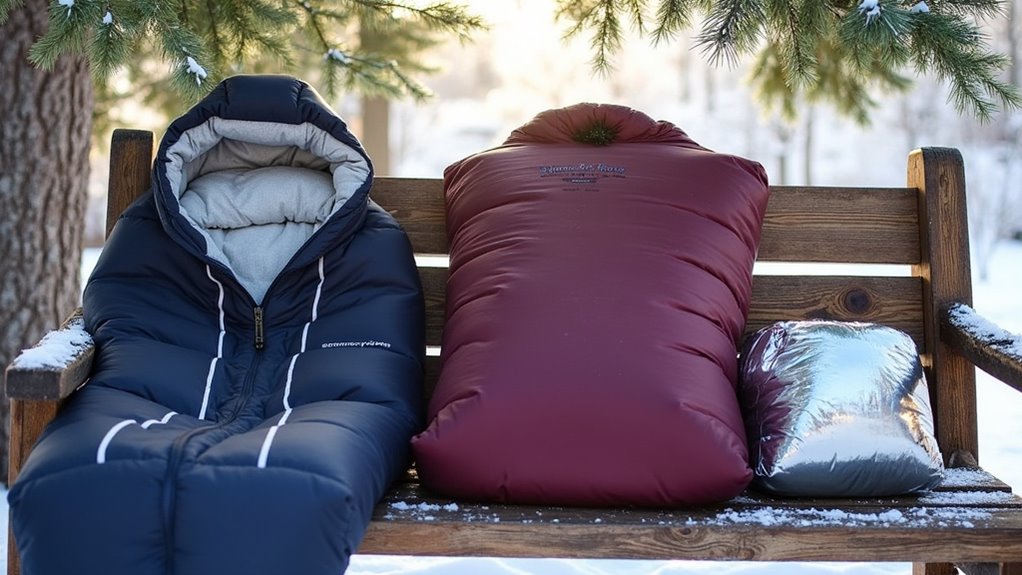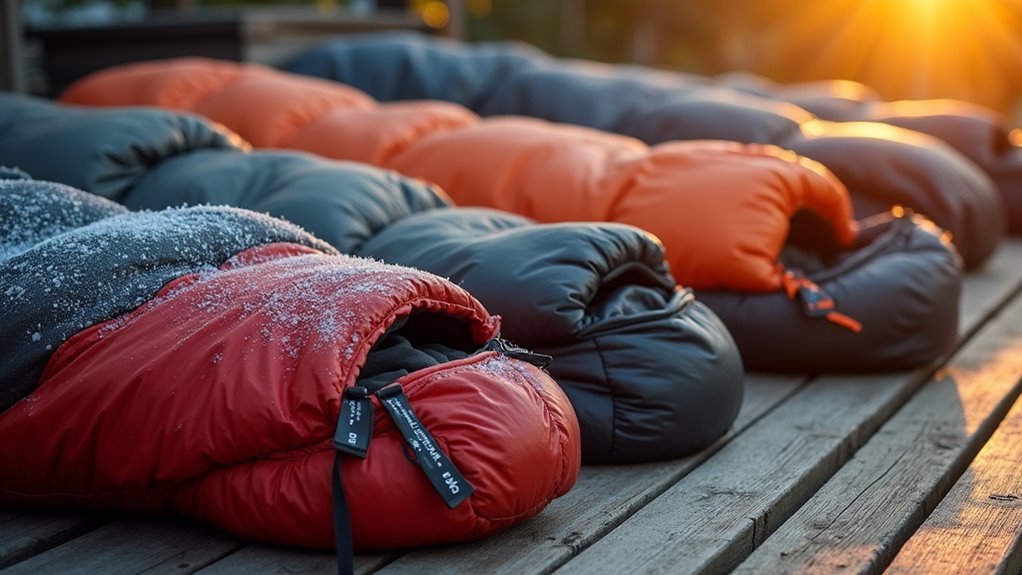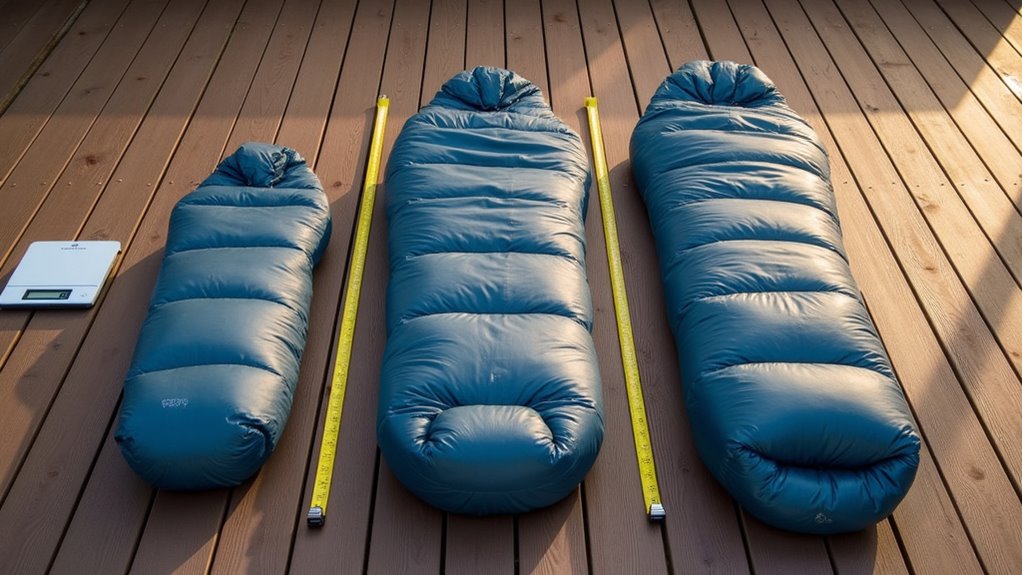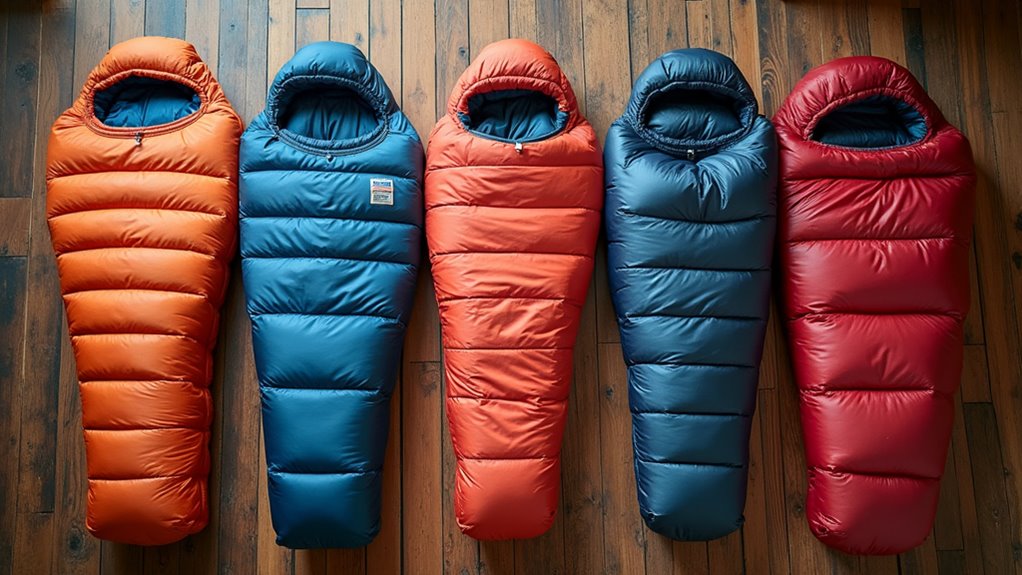Physical Address
304 North Cardinal St.
Dorchester Center, MA 02124
Physical Address
304 North Cardinal St.
Dorchester Center, MA 02124

Mastering winter camping starts with choosing the perfect sleeping bag, but comfort and warmth depend on more than just temperature ratings.
You’ll find that choosing the right sleeping bag isn’t just about picking the warmest option available. European winters demand smart decisions that balance comfort, cost, and practicality. Whether you’re planning a trek through the Alps or camping in Scotland’s Highlands, your choice of sleeping bag can make or break your outdoor experience. Let’s explore how temperature ratings, fill materials, and clever design features work together to keep you cozy without emptying your wallet.

When you’re trying to stay warm in Europe’s diverse climate zones, understanding temperature ratings becomes your essential first step in selecting the right gear.
You’ll need to focus on CLO values, which measure insulation effectiveness. For instance, if you’re traveling through Nordic countries, you’ll want gear with higher CLO ratings, like those found in cold storage equipment (up to 2.59 CLO). Manufacturers provide four warmth levels to help travelers choose appropriate cold-weather defense gear.
Consider your planned activities while exploring European destinations. Higher MET levels from walking tours or hiking will require less insulation than standing still at outdoor markets. Winter camping boots are essential for your adventures in cold weather.
Active sightseeing generates body heat, so pack lighter layers for hiking but warmer gear for stationary activities like market browsing.
Don’t forget to factor in exposure time – you’ll need more insulation for long winter evenings in Berlin than for quick city walks in Madrid.
Check thermal rating guides from European brands, but remember to cross-reference them as rating systems vary between manufacturers.
Building on your temperature rating knowledge, let’s examine the specific design elements that make cold-weather bags effective for European conditions.
When shopping for a winter bag in Europe, you should focus on features that maximize warmth retention. Look for mummy-shaped bags with full-length draft tubes along the zippers and an adjustable hood with a draft collar. These elements prevent precious heat from escaping around your neck and through seams. Hydrophobic down treatment provides crucial protection against European moisture while maintaining superior insulation properties.
Make certain your bag includes strategically placed insulation zones, particularly around the feet where European winter moisture can be problematic. The shell should feature ripstop nylon with DWR coating to handle damp conditions common in places like Scotland or the Alps. Top winter sleeping bags can provide the warmth and protection needed for your European adventures.
Don’t overlook internal pockets – they’re invaluable for keeping electronics and essentials warm in freezing temperatures.

Understanding insulation materials is essential for European adventurers since each fill type performs differently across varied climates – from the wet Scottish Highlands to the dry Alpine peaks.
Smart adventurers match their gear’s insulation to Europe’s diverse conditions, ensuring comfort from Scotland’s wet glens to pristine Alpine terrain.
You’ll find that down insulation excels in dry conditions, offering superior warmth-to-weight ratios with high fill power ratings (800-900). It’s perfect for Alpine treks where moisture isn’t a concern, though it’ll cost more upfront. For Britain’s damper regions, synthetic fills are your smarter choice – they’ll keep you warm even when wet and won’t break your budget. Due to site maintenance work, OutdoorGearLab’s detailed synthetic fill reviews will be accessible again shortly.
Essential sleeping bags for your next outdoor adventure can also be a great option, as they provide the versatility to handle different climates and conditions. Consider hybrid bags for versatile European travel. They combine synthetic insulation on moisture-prone areas with down where it matters most.
You’ll get the best of both worlds: reliable performance in varied conditions and a reasonable price point that works for multi-country adventures.
Since winter camping demands reliable protection against extreme cold, choosing the right sleeping bag becomes essential for European adventures. Among the leading high-performance options, the 800+ fill power is key for superior warmth-to-weight ratio in winter bags.
You’ll find the Robens Serac 900 offers exceptional value at £351.99, with a comfort rating of -12°C and limit rating of -20°C, making it ideal for harsh European winters. Its stretch baffles allow natural movement while maintaining warmth. Essential Gear for a Cozy Winter Camping Adventure can help you further understand the importance of selecting the right sleeping bag for your winter camping needs.
For more extreme conditions, consider The North Face Inferno or Western Mountaineering Puma Super MF. These premium options deliver reliable performance in severe cold but come at a higher price point.
If you’re working with a tighter budget, the Sierra Designs Get Down 20 provides good warmth for less demanding winter conditions.
Whatever you choose, focus on the comfort rating rather than the limit rating to guarantee you’ll stay genuinely warm throughout your outdoor adventures.

When planning extended European backpacking trips, managing your pack’s weight becomes essential for both comfort and safety. You should aim to keep your loaded pack around 20% of your body weight – for example, if you weigh 150 pounds, aim for a 30-pound pack maximum.
For multi-country European journeys, consider upgrading to lightweight gear to stay within comfortable limits. Switch to a water filtration system instead of carrying multiple water bottles, and opt for a quilt rather than a bulky sleeping bag when traveling in milder Mediterranean climates. Using a detailed gear list helps prevent overpacking unnecessary items. Essential camping gear is crucial for a successful trip.
If you’re targeting the lightweight category (10-20 pounds base weight), you’ll find plenty of affordable options at European outdoor retailers. Remember that winter trips through Northern Europe will require warmer gear, so plan accordingly and adjust your weight expectations.
Modern European gear manufacturers have revolutionized bag warmth through sophisticated technologies and thoughtful design elements.
You’ll find bags featuring advanced synthetic insulation like ThermoBall™ and Heatseeker™, offering exceptional warmth-to-weight performance while maintaining effectiveness in damp conditions.
Many European brands now incorporate smart warming features, including USB-powered heating elements and thermal-reflective linings. The integration of modular storage compartments allows users to add or remove insulation layers based on temperature needs.
For practical warmth enhancement, look for bags with hybrid construction that combines synthetic and down insulation. Waterproof sleeping bags are essential for maintaining heat efficiency, especially in wet conditions.
These designs often include adjustable panels letting you customize warmth levels based on conditions.
Don’t overlook the importance of seam-sealed construction and weatherproof materials – they’re essential for maintaining heat efficiency.
When shopping, prioritize models with ergonomic, body-hugging shapes that minimize cold spots and maximize thermal retention.

Under €50, you’ll find basic choices like JEAOUIA and Oaskys models, suitable for warm-weather camping but limited in features. The Oaskys model features a user-friendly hood that provides extra warmth and reduces noise during sleep. The essential camping pillow can be a valuable addition to your camping gear.
The €50-100 range presents better value, with standouts like the Alpkit PipeDream 200 offering an excellent warmth-to-weight ratio for European conditions.
Moving up to €100-150, you’ll discover the Mountain Equipment Starlight series, particularly well-suited to European climates.
The Starlight 1 excels in summer conditions at 9°C, while the Starlight 2 extends your camping season with its 3°C rating.
For those seeking premium performance, the €150-200 category features down-filled options like the Kelty Cosmic 20, delivering superior warmth-to-weight benefits for serious backpacking adventures.
Beyond budget considerations, sustainability has emerged as a key factor in cold-weather sleep system selection across Europe. You’ll find excellent eco-friendly options from European manufacturers like Mountain Equipment and Rab, who’ve pioneered 100% recycled materials in their sleeping bags.
The Classic Eco range showcases how Down Cycle® initiative has revolutionized sustainable sleeping bag production since 2017. Plus, 8 Eco-Friendly Camping Sleeping Bags provide a variety of sustainable options to consider.
To make a sustainable choice, look for RDS or TDS certifications when selecting down bags, or opt for synthetic fills with at least 50% recycled content. PFC-free water repellent treatments offer environmental safety without compromising performance.
For wet European climates, synthetic bags often prove more practical and require less maintenance.
Consider durability alongside sustainability – invest in high-quality bags with repair options and replaceable parts. Brands like Mountain Hardwear’s Lamina Eco AF series demonstrate that you don’t need to sacrifice performance for environmental responsibility.
You’d think spending more would guarantee the warmest nights, but ironically, some of Europe’s best-value sleeping bags outperform their pricier rivals. Don’t let flashy marketing fool you – smart shoppers know that mid-range options like the Robens Serac often deliver better warmth-to-euro ratios. By focusing on practical features and temperature ratings rather than brand names, you’ll stay cozy without freezing your bank account.